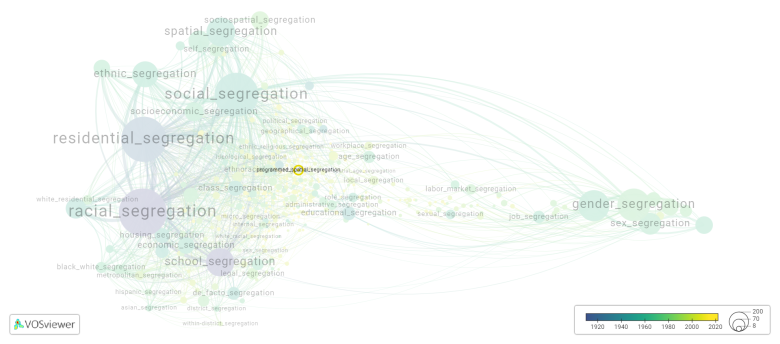Programmed spatial segregation: Difference between revisions
(Creating page) |
(Creating page) |
||
| Line 16: | Line 16: | ||
[[File:programmed_spatial_segregation.png|780x780px]] | [[File:programmed_spatial_segregation.png|780x780px]] | ||
Visualization based on the [[How_to_cite_Segregation_Wiki| research]] | |||
For the complete network of associated segregation forms, see: | For the complete network of associated segregation forms, see: | ||
year of publication https://tinyurl.com/2235lkhw | * First year of publication https://tinyurl.com/2235lkhw | ||
Louvain clusters https://tinyurl.com/2d8wg5n3 | * Louvain clusters https://tinyurl.com/2d8wg5n3 | ||
* Betweenness centrality https://tinyurl.com/223udk5r | |||
* Disciplines where segregation forms first appeared https://tinyurl.com/244d8unz | |||
==References== | ==References== | ||
==Notes== | ==Notes== | ||
Revision as of 13:41, 3 October 2024
Date and country of first publication[1]
2020
Brazil
Definition
Programmed spatial segregation refers to a deliberate design strategy or development policy that intentionally separates different land uses or population groups within a city or urban area. This can take many forms, such as zoning laws that separate residential and commercial areas, or the creation of gated communities that restrict access to certain groups of people.
The goal of programmed spatial segregation can vary, but it is often intended to promote safety, improve property values, or maintain a certain quality of life for residents. However, critics argue that this type of segregation can lead to social inequality, economic disparities, and limited access to resources for certain groups.
Overall, programmed spatial segregation plays a significant role in shaping the physical and social fabric of cities, and it is important to consider the long-term implications of such policies on communities and their residents.
See also
Related segregation forms
Programmed spatial segregation is frequently discussed in the literature with the following segregation forms:
Visualization based on the research
For the complete network of associated segregation forms, see:
- First year of publication https://tinyurl.com/2235lkhw
- Louvain clusters https://tinyurl.com/2d8wg5n3
- Betweenness centrality https://tinyurl.com/223udk5r
- Disciplines where segregation forms first appeared https://tinyurl.com/244d8unz
References
Notes
- ↑ Date and country of first publication as informed by the Scopus database (December 2023).
At its current state, this definition has been generated by a Large Language Model (LLM) so far without review by an independent researcher or a member of the curating team of segregation experts that keep the Segregation Wiki online. While we strive for accuracy, we cannot guarantee its reliability, completeness and timeliness. Please use this content with caution and verify information as needed. Also, feel free to improve on the definition as you see fit, including the use of references and other informational resources. We value your input in enhancing the quality and accuracy of the definitions of segregation forms collectively offered in the Segregation Wiki ©.
Programmed spatial segregation appears in the following literature
Martines M.R., Cavagis A.D.M., Kawakubo F.S., Morato R.G., Ferreira R.V., Toppa R.H. (202). Spatial segregation in floodplain: An approach to correlate physical and human dimensions for urban planning. Cities, 97(), -. Elsevier Ltd.https://doi.org/10.1016/j.cities.2019.102551

